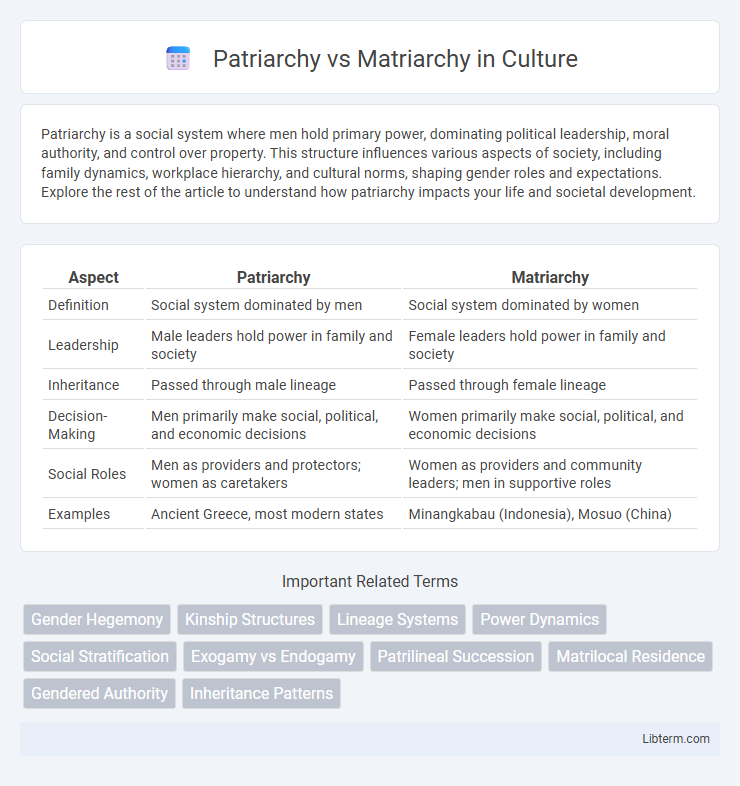Patriarchy is a social system where men hold primary power, dominating political leadership, moral authority, and control over property. This structure influences various aspects of society, including family dynamics, workplace hierarchy, and cultural norms, shaping gender roles and expectations. Explore the rest of the article to understand how patriarchy impacts your life and societal development.
Table of Comparison
| Aspect | Patriarchy | Matriarchy |
|---|---|---|
| Definition | Social system dominated by men | Social system dominated by women |
| Leadership | Male leaders hold power in family and society | Female leaders hold power in family and society |
| Inheritance | Passed through male lineage | Passed through female lineage |
| Decision-Making | Men primarily make social, political, and economic decisions | Women primarily make social, political, and economic decisions |
| Social Roles | Men as providers and protectors; women as caretakers | Women as providers and community leaders; men in supportive roles |
| Examples | Ancient Greece, most modern states | Minangkabau (Indonesia), Mosuo (China) |
Understanding Patriarchy and Matriarchy
Patriarchy is a social system where men hold primary power in roles of political leadership, moral authority, and control of property, often shaping societal norms and institutions. Matriarchy, though less common, centers power around women, particularly in lineage, inheritance, and leadership positions within a community or culture. Understanding these structures involves examining gender roles, authority distribution, and cultural practices that define how power and influence are established and maintained.
Historical Roots of Patriarchal Societies
Patriarchal societies have roots in ancient agricultural communities where male strength was essential for plowing and defending territory, leading to men's dominance in social and political structures. Historical records from Mesopotamia, Ancient Greece, and Rome reveal entrenched male authority codified in laws and cultural norms. This gender hierarchy was reinforced through religious doctrines and inheritance systems privileging male heirs, perpetuating patriarchal dominance across centuries.
Matriarchal Societies: Fact or Myth?
Matriarchal societies, where women hold primary power in political leadership, moral authority, and control over property, are rare and often debated among anthropologists. Some cultures, such as the Mosuo in China and the Minangkabau in Indonesia, exhibit matrilineal and matrifocal traits, but these do not equate to full matriarchies with female dominance across all societal aspects. The concept of a true matriarchy remains largely theoretical, with most historical and contemporary societies being predominantly patriarchal or showing mixed gender power dynamics.
Gender Roles in Patriarchy vs Matriarchy
In patriarchal societies, gender roles typically assign men authority and dominance in political, economic, and social spheres, while women are often relegated to domestic and caregiving responsibilities. Matriarchal systems, by contrast, prioritize female leadership and lineage, with women holding central roles in decision-making and inheritance, influencing culture and governance. These contrasting frameworks shape societal norms, power distribution, and individual identities based on gender.
Power Structures and Leadership Dynamics
Patriarchy centralizes power within male leadership, often institutionalizing authority through patrilineal inheritance and male-dominated governance, reinforcing gender hierarchies and restricting women's societal roles. Matriarchy shifts power to female leadership, emphasizing matrilineal descent and shared communal responsibilities, fostering collaborative decision-making and inclusive social dynamics. The contrast highlights how power structures influence leadership roles, social organization, and the distribution of authority based on gender.
Social and Economic Impacts
Patriarchy often concentrates economic power and decision-making within male-dominated structures, leading to gender wage gaps, limited access to resources for women, and reinforced social hierarchies. Matriarchal societies tend to promote more egalitarian resource distribution and cooperative social networks, which can enhance community resilience and economic stability. Socially, patriarchy frequently perpetuates gender roles that constrain women's participation in leadership, while matriarchy encourages inclusion and collective responsibility in both family and economic spheres.
Family Organization and Inheritance Systems
Patriarchy organizes family structure with male authority, typically passing inheritance and family names through the male line, reinforcing male dominance in property and decision-making. Matriarchy centers authority around women, often tracing lineage and inheritance through the female line, ensuring property and social status are maintained within maternal kinship. These contrasting systems influence social roles, power dynamics, and the distribution of resources within families, shaping broader cultural norms.
Cultural Narratives and Belief Systems
Cultural narratives in patriarchal societies often emphasize male dominance, lineage, and authority, reinforcing gender hierarchies through myths, religious texts, and social rituals. In contrast, matriarchal belief systems celebrate female leadership, communal decision-making, and nurturing roles, embedding these values in oral traditions, spiritual practices, and social structures. These divergent frameworks shape identity, power distribution, and social norms, profoundly influencing gender roles and interpersonal relationships within each society.
Contemporary Debates: Shifts in Gender Power
Contemporary debates on patriarchy versus matriarchy highlight significant shifts in gender power dynamics as societies increasingly challenge traditional male-dominated structures. Feminist movements and gender equality policies have catalyzed a reevaluation of patriarchal norms, promoting inclusivity and balanced decision-making roles for all genders. Emerging matriarchal practices in certain indigenous and progressive communities showcase alternative models of leadership, emphasizing cooperation, nurturing, and collective well-being.
The Future of Gendered Social Structures
The future of gendered social structures hinges on evolving power dynamics as societies increasingly challenge traditional patriarchy and matriarchy frameworks. Emerging models prioritize gender equity, fluidity, and inclusivity, reshaping governance, family roles, and economic participation. Technological advancements and global activism drive the decentralization of gendered authority, promoting hybrid systems over rigid hierarchical norms.
Patriarchy Infographic

 libterm.com
libterm.com